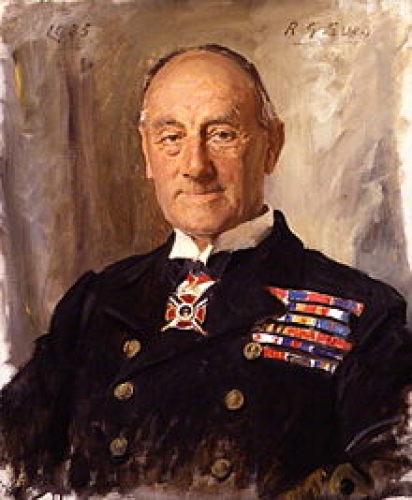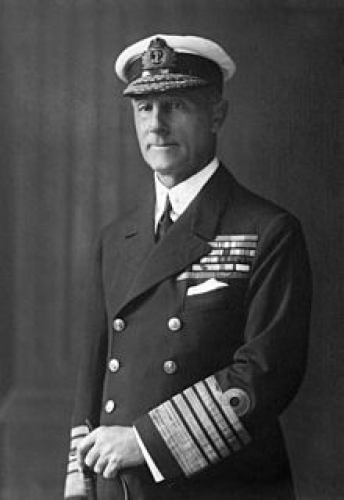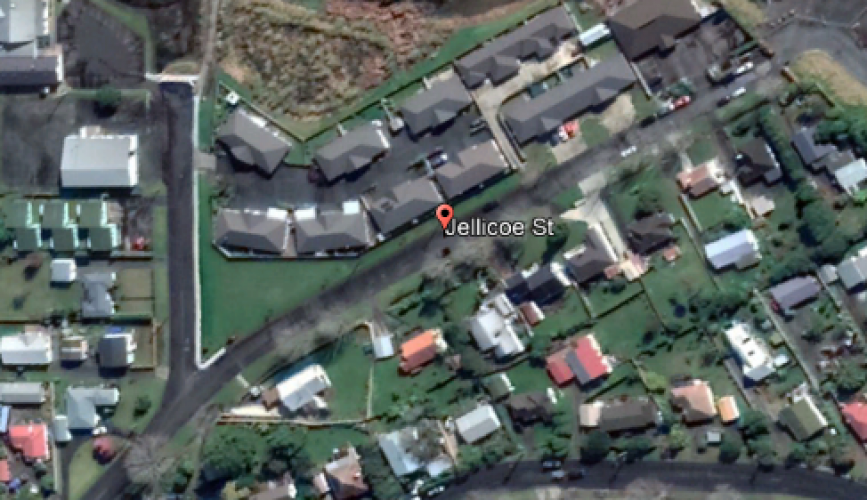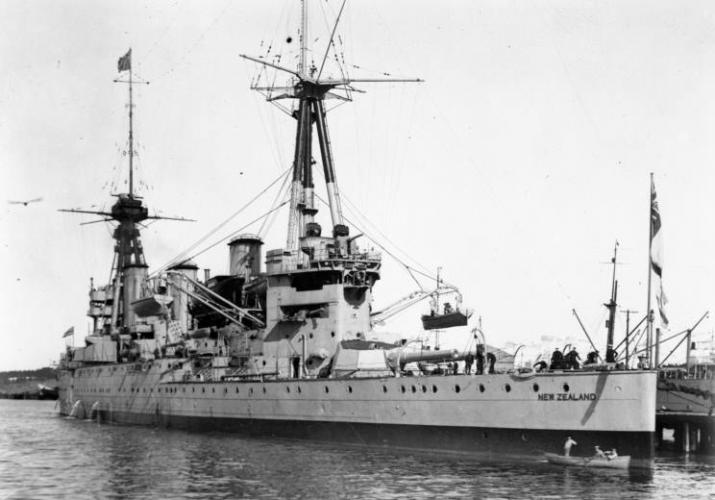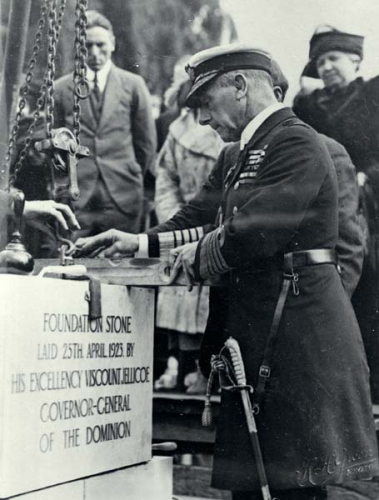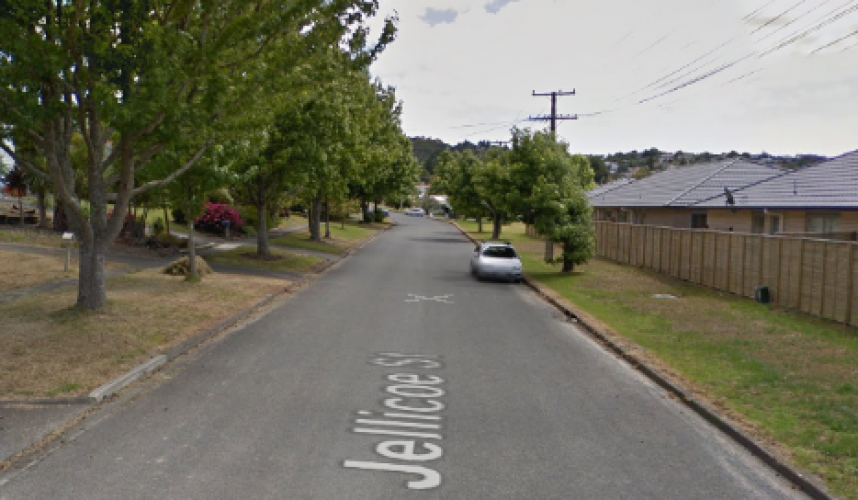300 Jellicoe St Morningside Whangarei, street scene 2018
Reason for the name
This street in Whangarei was named after Sir John Rushworth Jellicoe. John Jellicoe was born on the 5th December 1859 in Southampton, Hampshire, England. Jellicoe was married on 1st July 1902 and had one son and five daughters. He died at the age of 75 of pneumonia on 20th November 1935 in his hometown Kensington London England and is buried in the crypt of St. Paul's cathedral. His initial association with New Zealand was during the First World War when he was the Admiral of the Fleet during the battle of Jutland.
Jellicoe joined the Royal Navy as a cadet in the training ship HMS Britannia in 1872. He was promoted to sub-lieutenant in 1878 and then promoted to lieutenant in 1880, commanding a rifle company of the Naval Brigade during the Egyptian War of 1882.
At the start of the First World War, Jellicoe was promoted to full admiral on 4 August 1914 and assigned command of the ‘Grand Fleet’ 1914-1916. He was in command of the British Grand Fleet at the Battle of Jutland, history’s largest clash of dreadnoughts. The Fleet was brought into action on 31st May, 1916, to the westward of the Jutland Bank, off the coast of Denmark, to intercept the German High Seas Fleet.
Author: The Poppy Places Trust and Cherie Flintoff, Hastings District Council.
The Battle of Jutland
In May 1916 the Battle of Jutland occurred when commanders of both the German High Seas Fleet and the Grand Fleet planned offensive operations to draw the other out, using a range of ships with aircraft and submarines. The British with the advantage of intelligence from its code-breaking section in Room 40 of the Admiralty were aware that the High Seas Fleet was putting to sea on 30 May.
Admiral Jellicoe in command of the Grand Fleet was informed and ordered Admiral Beatty to take the Battle Cruiser Fleet to sea from Rosyth and sailed himself with the Grand Fleet from Scapa Flow. Admiral Hipper took the German battle cruisers to sea at 1.00am on 31 May with the intention of drawing out the British battle cruisers, which he would then lead into a trap with the High Seas Fleet under Admiral Sheer.
The two forces steamed towards each other, the British with eight battle cruisers and 29 battleships and the Germans with five battle cruisers and 22 battleships. HMS New Zealand, a Royal Navy ship funded by New Zealand was in the 2nd Battle Cruiser Squadron. The battle was intense, with faulty signalling at times meaning the British fleet didn’t always press home its numerical advantage. Beatty’s flagship, Lion, was hit several times, but at 4.02pm three shells from von der Tann hit Indefatigable which caused it to pull out of line and two further hits resulted in a terrific explosion and the ship disappeared.
The battle continued and at 4.26pm Queen Mary took a full salvo of four 11 inch shells from Seydlitz, suffering a massive explosion and quickly broke apart. HMS New Zealand, the next astern steamed past the spot, debris landing on its decks. It was at this point that Beatty uttered one the most quoted statements about Jutland “There seems to be something wrong with our bloody ships today.”
Both fleets had “succeeded” in drawing the other out. When the High Seas Fleet was sighted, Beatty turned away to draw the High Seas Fleet towards Jellicoe and the Grand Fleet, a manoeuvre that became known as the “sixteen point turn at Jutland”. Again signalling was a problem. The 5th Battle Squadron could not see the flag signals from HMS Lion and Beatty had not signalled Jellicoe of the sighting of the High Seas Fleet. Nevertheless as the ships now steamed north, the battle continued, with the heavy guns of the 5th Battle Squadron causing much damage to the German battle cruisers.
By 6.00pm Jellicoe was only 8½ miles from the battle but could only see gun flashes – none of his forces had told him where the Germans were. At this time the 3rd Battle Cruiser Squadron had been detached to join Beatty and provided a shock to Admiral Hipper. At the start of the afternoon there had been five British battle cruisers and he had sunk two, but now there were six! The battle continued, and at 6.33pm HMS Invincible received several hits in succession and like Indefatigable and Queen Mary, disappeared in a blinding explosion.
Now the Grand Fleet was in range and opened fire on the German ships. Admiral Sheer was aware of his predicament and turned away. The visibility by now was patchy and deteriorating. Jellicoe was between Sheer and Germany and had all intentions of renewing the engagement the following day, unfortunately during the night, the German fleet managed to sneak between the rear of the British line and make it safely back into harbour.
Jutland was a decisive sea battle. German losses in the battle were less than the British, but strategically, the German Fleet only ventured to sea on two further occasions before the end of the war.
The HMS Invincible was one of the British ships lost in the battle. It was commanded by Rear-Admiral the Hon. Horace L. A. Hood, C.B., M.V.O., D.S.O the Commander of the Third Battle-cruiser Squadron, and when it was sunk killed all but six of those on board.
Sir John Jellicoe's Report on the Battle of Jutland, 31 May-1 June 1916 provides more information on the battle. Jellicoe published numerous books following the war, including The Grand Fleet 1914-16 (1919) and The Crisis of the Naval War (1921). Following the war, Admiral Jellicoe was tasked with helping to plan and coordinate the naval policies and defences of the British Dominions. HMS New Zealand was made available for his transportation, and was refitted for the tour.
Governor General of New Zealand 1920-1924
John Rushworth Jellicoe first travelled to New Zealand in August 1919 while undertaking a review of the Empire’s naval defences. His visit aboard the Indefatigable-Class battlecruiser HMS New Zealand proved immensely popular with the public, who came out in their thousands to view the ship and its famous passenger. Jellicoe himself was so well received that he returned to serve as Governor-General the following year.
Jellicoe was appointed the second Governor-General of New Zealand in 1920 and also served as Grand Master of New Zealand's Masonic Grand Lodge. Jellicoe was a keen yachtsman and had a 14 foot yacht, “Iron Duke”. (HMS Iron Duke served as the flagship of the Grand Fleet during the First World War, including the Battle of Jutland. There, she inflicted significant damage on the German battleship SMS König early in the main fleet action. On 25 May, 1915, Iron Duke carried Jellicoe to Rosyth to meet with Admiral Henry Jackson, the new First Sea Lord.)
Dunedin yachtsmen challenged Jellicoe to a race in Auckland. A trophy was presented by Messers Walker and Hall Ltd. The trophy was in memory of Lieutenant Commander W.E. Sanders VC who died heroically during the First World War. Jellicoe was patron of many yacht clubs in New Zealand.
Jellicoe obviously made an impact during his term as Governor General, with many landmarks being named after him. A few of these included Jellicoe Pool, Tongariro River (a favourite fishing spot of Admiral John Jellicoe) and Jellicoe Point, Lake Taupo (a favourite fishing campsite). Jellicoe Cave, Northland, situated at the entrance to Whangaroa Harbour. Admiral John Jellicoe was given a tour of the area during his term as Governor-General.
Other places named after him include Jellicoe Peak, Southern Alps, and Jellicoe Ridge, Canterbury. In 1934, the members of the Auckland Harbour Board moved that the three approach passages in channels connecting the Hauraki Gulf / Tīkapa Moana to the Pacific Ocean be given names in honour of a popular Governor-General, and Jellicoe Channel became one of them. Following his return to England, he was created Earl Jellicoe and Viscount Brocas of Southampton in the County of Southampton on 1st July 1925.


